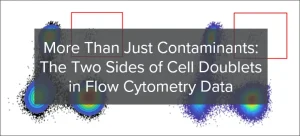August 15, 2024

Flow cytometry (including cell sorting) provides unprecedented levels of detail about blood samples for both research and clinical applications, allowing for instance the unraveling of phenotypic heterogeneity of human immune cells.
However, research from the Burel group , La Jolla Institute for Immunology, highlighted that blood-derived cell doublets can be present in single-cell data derived from flow cytometry analyses.
Doublet exclusion methods, commonly based on Forward Scatter (FSC)/Side Scatter (SSC) Area/Width/Height measurements, can partly remove cell doublets, but some complexes remain undetected, leading to data misinterpretation.
While cell doublets often need removing, interestingly, Burel reported that some doublets form naturally — which could provide greater disease understanding.
Here we look at what cell doublets are, their risk and promise, and how analysts can ensure accurate results.
Seeing Double: Identifying Cell Doublets in Flow Cytometry
While dual lineage co-expressing cell populations (also called dual expressor cells) exist in human peripheral blood samples analysed by flow cytometry, Burel’s team recently unveiled through imaging that some of these events are actually cell-cell complexes.
In the live singlet gate of blood-derived samples, T cells can still be bound to other immune cells, such as antigen-presenting cells (APC), de facto forming a cell doublet. But without deeper analysis, it can be easy to analyze cell doublets as single cells.
In cell sorting applications, the cell doublets can subsequently generate atypical gene signatures of mixed cell lineage, meaning that data misinterpretation can occur, including:
- Specific cell population percentage deflation,
- Novel immune cell type misidentification, and
- Incorrect functional marker expression attribution.
Distinguishing cell-cell complexes for more accurate Flow Cytometry results
Experimental and data analysis strategies can distinguish between singlets and cell doublets for more accurate data.
To detect the presence of cell-cell complexes within potential dual-expressing cells, Burel’s team used two different approaches:
- Cell sorting followed by direct microscopy imaging to confirm the expression of markers on distinct cells
- Imaging flow cytometry to generate metrics from pictures of the detected events, enabling doublet exclusion using brightfield area and aspect ratio parameter calculation.
Notably, Burel’s team found that cell-cell complexes have molecular signatures that clearly distinguish them from singlets at both protein and mRNA levels, providing analysts with a way to avoid data misinterpretation.
When looking at cell–cell complex signatures with SSC/FSC and SSC/CD45, the team discovered that the complexes had higher levels of CD45, SSC, and FSC expression compared to single cells.
Importantly, cell doublets aren’t always just contaminants. The team found that T cell-APC complexes that form in vivo as a natural immunological process can be detected in the singlet gate of ex vivo human blood samples analyzed by flow cytometry, in quantities that vary over time depending on the disease state.
As such, it is therefore believed that they could provide deeper insights into research and diagnosis.
Integration of Techniques from Doublet Discrimination and Exclusion: Techniques and Detailed Process
Practical Applications of Doublet Discrimination in Flow Cytometry Analyses
Proper doublet discrimination ensures increased data accuracy and enhanced data quality. Therefore, proper singlet gating strategies in flow cytometry analyses are essential for ensuring that only single-cell events are analyzed, leading to more reliable and reproducible results.
There are essentially two main techniques for identifying and gating singlet events in flow cytometry data:
- Pulse Processing: incorporating Area, Height and Width bi-variate plots for FSC and SSC parameters in the hierarchical gating strategy can help identify and exclude doublets based in their distinct scatter profiles.
- Autofluorescence extraction: in full-spectrum cytometry, a technology that captures the entire fluorescence spectrum emitted by each fluorochrome, the autofluorescence of the sample (natural emission of light by biological structures) can be extracted as well and used to discriminate doublets. This is particularly useful for analyzing tissues or cells with high levels of autofluorescence, such as lung tissues or certain cell types in immunology and oncology research.
Singlet vs. Doublet Flow Cytometry Analysis
Understanding the differences between singlets and doublets is crucial for precise flow cytometry analysis. The following table highlights key distinctions:
| Feature | Singlet Flow Cytometry | Doublet Flow Cytometry |
|---|---|---|
| Cell Type | Single cells | Doublet cells |
| Identification Method | Linear relationship in FSC and SSC pulse dimensions (Area, Height, Width) | Deviations from linear relationship |
| Data Accuracy | High | Can lead to data misinterpretation |
| Analysis Focus | Individual cell analysis | Potentially confounded by cell aggregates |
| Impact on Results | Accurate cell population quantification | Potentially confounded by cell aggregates |
Leverage expertise for maximum data confidence in Flow Cytometry
Addressing the issue of cell doublets in flow cytometry is essential for maintaining data accuracy and quality.
By employing effective doublet discrimination and singlet gating techniques, researchers can ensure that their flow cytometry data reflects true single-cell events. This leads to more reliable and reproducible results, ultimately advancing our understanding of complex biological systems.
Our analytical team has the expertise to tailor gating strategies based on the presence of cell-cell complex doublets. CellCarta offers a broad range of advanced services using robust techniques to get greater insights from your studies. Contact the team to learn more.

Roxanne Collin is a Research Scientist within the Development group of the Data Analysis Unit at CellCarta. She holds a PhD in immunology with a focus on the immunogenetics of rare cell populations. At CellCarta, she is participating in the optimisation of flow cytometry panels and gating strategies for a broad variety of immune cell types.
You might also be interested by
Posters
High Quality Whole Transcriptome RNA-Sequencing from Challenging Clinical Samples
June 23, 2025
More infoPosters
Performance Evaluation of an Ultra-Sensitive Assay for NSCLC Biomarker Testing
June 23, 2025
More infoCellTalk Blog
CROs vs. CMOs vs. CDMOs: Understanding the Differences in Outsourcing Partners
June 10, 2025
More infoCellTalk Blog
What is a Contract Research Organization (CRO), and How Do You Choose the Right One?
June 4, 2025
More info